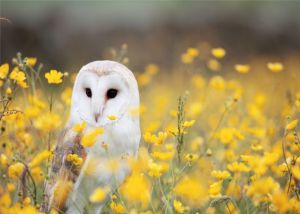Similarities between Owls and Barn Owls
From diff.wiki
Revision as of 13:32, 13 August 2020 by BelemMar (talk | contribs) (Created page with "thumb|left thumb|right Owls are divided into two families; the true (typical) owl and the barn...")
Owls are divided into two families; the true (typical) owl and the barn-owl. These two kinds of owls are both nocturnal birds of prey. Although both of them share the same order (Strigiformes), there are some differences in their behavior, looks and habits.
| Owl | Barn-owl | |
|---|---|---|
| Taxonomy | Strigiformes order, strigidae family. | Strigiformes order, tytonidae family. |
| Appearance | Owls have ear-simulating feathers. Their big eyes are yellow most of the times. Since they can’t really move their eyes, they have between 12 and 14 neck vertebrae, which allow them to rotate their heads up to 270°. Their heads are big and round shaped. Owls can be found in a variety of colors. | Unlike regular owls, barn-owls don’t have ear-simulating feathers. Their flat faces are their main characteristic along with their wide foreheads and pointy chins. Barn-owls tend to be smaller in size than regulars owls. |
| Behavior | Owls are nocturnal birds. They have the capacity of hunting in complete darkness due to their magnificent hearing and sight. Owls are lonely birds, although some species do prefer to live in small groups. Also, some species migrate, but not all of them. | As for barn-owls, they are also nocturnal habits birds. When young, barn-owls are lonely, highly territorial birds. Later on, they form pairs. Most barn-owls species are monogamous and mate for life. They will keep on defending their nesting area, but not their hunting sites. |
| Location | Owls can be found in every continent except for the Antarctica. Their physical appearance variates along with the climatic and geographical conditions they live in. Owls physically adapt to their surroundings. | Barn-owls can also be found everywhere around the globe. However it is more common to find this kind of birds in high mountain areas. Barn-owls can also adapt to their surroundings by changing their feathers colors. |
| Feeding habits | Owls can eat everything from invertebrates such as cockroaches, spiders and snails, to fish, small reptiles, amphibians, small mammals (such as rabbits, rats and mice) and even some other birds. | Mice and rats are their favorite prey, although they can eat a lot of other animals. Basically the same as regular owls. |
| Reproduction | Some owls are monogamous and mate for life. Either if they are monogamous or not, male and female only encounter each other on mating season. The female can lay anything from 2 to 12 eggs. Incubation lasts up to 30 days. Male and female take turns to hunt and to take care of their nest. | Barn-owls females lay between 5 and 7 eggs. Usually, males hunt while females take care of the incubation. |

